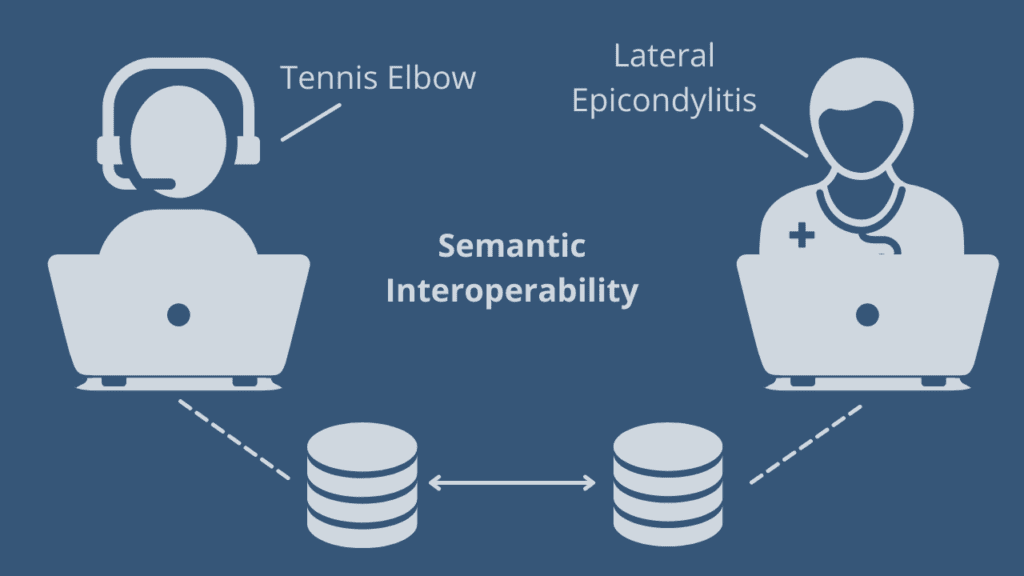
In healthcare, semantic interoperability creates common meaning when people and systems use different words and codes to describe the same thing.
In this post, we’ll focus on different words that people use to describe the same condition or diagnosis — and why & how these differences should be reconciled (technically “normalized”) in a healthcare environment.
When it comes to having a shared vocabulary about conditions and diagnoses, there are two fundamental obstacles:
1. The vast majority of healthcare organizations have multiple EHR systems from different vendors.
2. The same condition or diagnosis is often described using different words (synonyms) across different clinical software systems and in diverse care settings.
Generally, semantic interoperability is the “ability to use digital health data across diverse care settings and clinical software.” When it comes to words, semantic interoperability is, more specifically, “getting everyone within a healthcare system to speak the same language.”
Definitions
Let’s separately define each of the two words in “semantic interoperability.”
Semantic means “relating to meaning in language or logic.”
Interoperability means “the ability of computer systems or software to exchange and make use of information.”
By extension, “semantic interoperability” creates a common meaning for different people, regardless of which system they happen to be working in.
If there were a single, monolithic EHR, billing, and contact center system that everyone within a health system used, there would be no need to exchange data among systems.
The reality is that the propagation of different EHR, billing, and CRM vendor solutions within the same health system requires exchanging and normalizing data.
The semantic problem in healthcare
There are plenty of examples of both a common (layperson) term and a clinical term that describes the same condition.
If System A shows a patient has been diagnosed with “tennis elbow” and System B shows “lateral epicondylitis” for the same patient, the two systems should recognize that these two sets of words have a common meaning.
![]()
Here are two additional examples of synonyms that both clinicians and laypeople encounter regularly:
- “Whooping cough,” which is the common term for pertussis
- “Lou Gehrig’s disease,” which is the common term for amyotrophic lateral sclerosis (ALS)
As we mentioned in a previous post, common terms are often are suitable for contact center systems such as Salesforce Service Cloud. However, common terms can also find their way into clinical systems such as EHRs.
In addition, their synonyms and near-synonyms can exist exclusively within a clinical environment. For example, “extensor tendinopathy” and “extensor tendonitis” are sometimes used interchangeably.
“Extensor tendonitis” is most commonly used to describe inflammation of the extensor tendons that run along the top of the foot. However, the same words are sometimes used to describe inflammation of the extensor tendons in the elbow (tennis elbow).
Chronic obstructive pulmonary disease (COPD) is an umbrella term given to a group of chronic lung diseases that includes emphysema and chronic bronchitis.
The clinical problem
In the absence of semantic interoperability between the two systems in the above example, a patient can be construed as having multiple, separate conditions when there is only one.
Worse, a condition in a patient record in System A may be omitted altogether from a patient record in System B if System B cannot interpret the condition.
While tennis elbow is a condition that does not result in mortality, there are more serious conditions for which a lack of semantic interoperability among systems can have serious consequences.
The role of artificial intelligence in semantic interoperability
Mapping data among systems with a high incidence of synonyms and near-synonyms is more than humans alone can design. That’s where artificial intelligence comes into play.
An AI can learn that tennis elbow is the same as lateral epicondylitis and that whooping cough is the same as pertussis. In fact, an AI can learn hundreds of thousands of synonyms. When machine learning and artificial intelligence are involved, human intervention is only required a fraction of the time.
AI can be used to process, analyze, transform, validate and enrich data from our System A into a standardized form for consumption by our System B.
In other words, AI helps to map healthcare terminology by way of automated translation among systems.
The technology platform
To achieve semantic interoperability, a standardized model for the exchange of health-related information needs to be established across multiple systems and environments.
The solution is a cloud-based system that is used to manage semantic interoperability, which is more generally referred to as a managed terminology service.
The adoption of systems to better manage semantic interoperability has become increasingly common among HIEs and health systems.
An extended shared vocabulary
A shared vocabulary goes beyond describing conditions and diagnoses. Here are some examples:
1. Synonyms for ethnicity can be normalized.
2. A natural language processor can “read” free form physician notes and then transform that text into standardized codes and words that can be used for non-clinical purposes such as billing.
3. Patient-reported symptom data recorded in one system can be accurately transferred to a different system where it can contribute to assessment and monitoring.
4. Orders across different systems for the same medication can be compared and understood correctly.
5. Health measurement data such as blood pressure can be precisely transferred from one system to another.
The ability for semantic interoperability to produce common meaning within a health system or between an HIE and its members can be applied to many different types of information.




